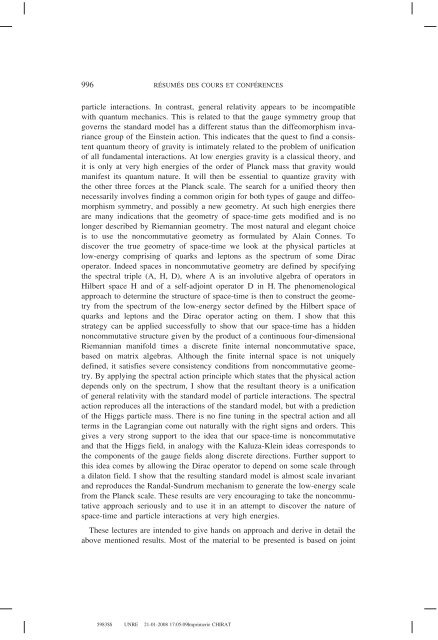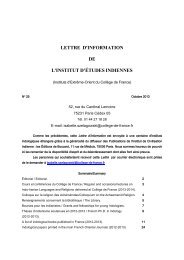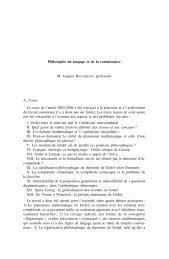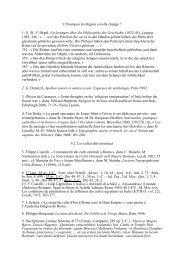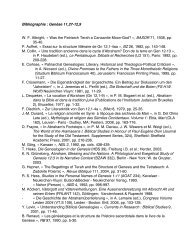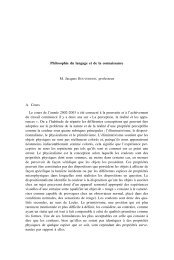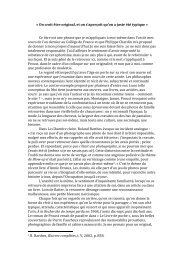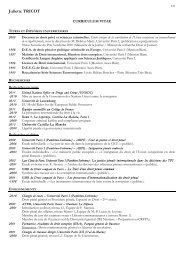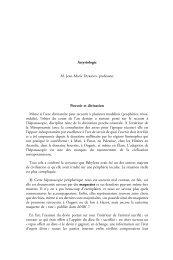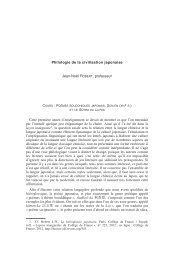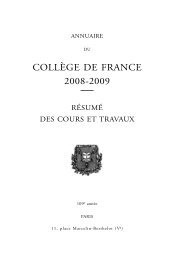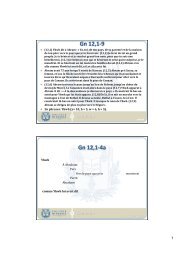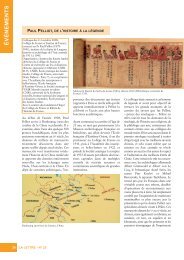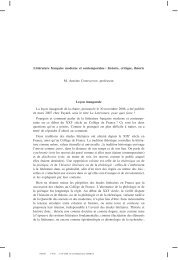annuaire partie 4 pdf - Cours et travaux - Collège - Collège de France
annuaire partie 4 pdf - Cours et travaux - Collège - Collège de France
annuaire partie 4 pdf - Cours et travaux - Collège - Collège de France
Create successful ePaper yourself
Turn your PDF publications into a flip-book with our unique Google optimized e-Paper software.
996<br />
RÉSUMÉS DES COURS ET CONFÉRENCES<br />
particle interactions. In contrast, general relativity appears to be incompatible<br />
with quantum mechanics. This is related to that the gauge symm<strong>et</strong>ry group that<br />
governs the standard mo<strong>de</strong>l has a different status than the diffeomorphism invariance<br />
group of the Einstein action. This indicates that the quest to find a consistent<br />
quantum theory of gravity is intimately related to the problem of unification<br />
of all fundamental interactions. At low energies gravity is a classical theory, and<br />
it is only at very high energies of the or<strong>de</strong>r of Planck mass that gravity would<br />
manifest its quantum nature. It will then be essential to quantize gravity with<br />
the other three forces at the Planck scale. The search for a unified theory then<br />
necessarily involves finding a common origin for both types of gauge and diffeomorphism<br />
symm<strong>et</strong>ry, and possibly a new geom<strong>et</strong>ry. At such high energies there<br />
are many indications that the geom<strong>et</strong>ry of space-time g<strong>et</strong>s modified and is no<br />
longer <strong>de</strong>scribed by Riemannian geom<strong>et</strong>ry. The most natural and elegant choice<br />
is to use the noncommutative geom<strong>et</strong>ry as formulated by Alain Connes. To<br />
discover the true geom<strong>et</strong>ry of space-time we look at the physical particles at<br />
low-energy comprising of quarks and leptons as the spectrum of some Dirac<br />
operator. In<strong>de</strong>ed spaces in noncommutative geom<strong>et</strong>ry are <strong>de</strong>fined by specifying<br />
the spectral triple (A, H, D), where A is an involutive algebra of operators in<br />
Hilbert space H and of a self-adjoint operator D in H. The phenomenological<br />
approach to d<strong>et</strong>ermine the structure of space-time is then to construct the geom<strong>et</strong>ry<br />
from the spectrum of the low-energy sector <strong>de</strong>fined by the Hilbert space of<br />
quarks and leptons and the Dirac operator acting on them. I show that this<br />
strategy can be applied successfully to show that our space-time has a hid<strong>de</strong>n<br />
noncommutative structure given by the product of a continuous four-dimensional<br />
Riemannian manifold times a discr<strong>et</strong>e finite internal noncommutative space,<br />
based on matrix algebras. Although the finite internal space is not uniquely<br />
<strong>de</strong>fined, it satisfies severe consistency conditions from noncommutative geom<strong>et</strong>ry.<br />
By applying the spectral action principle which states that the physical action<br />
<strong>de</strong>pends only on the spectrum, I show that the resultant theory is a unification<br />
of general relativity with the standard mo<strong>de</strong>l of particle interactions. The spectral<br />
action reproduces all the interactions of the standard mo<strong>de</strong>l, but with a prediction<br />
of the Higgs particle mass. There is no fine tuning in the spectral action and all<br />
terms in the Lagrangian come out naturally with the right signs and or<strong>de</strong>rs. This<br />
gives a very strong support to the i<strong>de</strong>a that our space-time is noncommutative<br />
and that the Higgs field, in analogy with the Kaluza-Klein i<strong>de</strong>as corresponds to<br />
the components of the gauge fields along discr<strong>et</strong>e directions. Further support to<br />
this i<strong>de</strong>a comes by allowing the Dirac operator to <strong>de</strong>pend on some scale through<br />
a dilaton field. I show that the resulting standard mo<strong>de</strong>l is almost scale invariant<br />
and reproduces the Randal-Sundrum mechanism to generate the low-energy scale<br />
from the Planck scale. These results are very encouraging to take the noncommutative<br />
approach seriously and to use it in an attempt to discover the nature of<br />
space-time and particle interactions at very high energies.<br />
These lectures are inten<strong>de</strong>d to give hands on approach and <strong>de</strong>rive in d<strong>et</strong>ail the<br />
above mentioned results. Most of the material to be presented is based on joint<br />
5983$$ UNRE 21-01-2008 17:05:09Imprimerie CHIRAT


